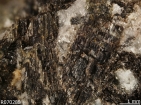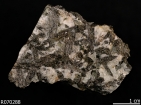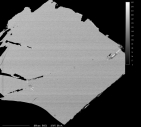 |
RRUFF Home | UA Mineralogy | Caltech Mineralogy | The IMA Mineral List | Login |
Important Update News
The RRUFF Project has been migrated to RRUFF.net. Please update your bookmarks immediately, if you have not done so.
The data on this website is already three years out of date, and the entire website will be taken offline before the end of the year.
We are grateful to NASA for the funding of this effort.

|

|
Name: Magnesio-hastingsite RRUFF ID: R070288 Ideal Chemistry: NaCa2(Mg4Fe3+)(Si6Al2)O22(OH)2 Locality: Dallas Gem Mine (Gem Mine; Benitoite Mine), New Idria District, San Benito County, California, USA Source: Michael Scott S104903 [view label] Owner: RRUFF Description: Dark brown to black prismatic crystals frozen in albite Status: The identification of this mineral is confirmed by single-crystal X-ray diffraction and chemical analysis. |
| Mineral Group: [ amphibole (107) ] | ||
| Quick search: [ All Magnesio-hastingsite samples (3) ] | ||
| CHEMISTRY | ||||||||||
|---|---|---|---|---|---|---|---|---|---|---|

|
|
|||||||||
| RAMAN SPECTRUM | ||||||||||||||||||||
|---|---|---|---|---|---|---|---|---|---|---|---|---|---|---|---|---|---|---|---|---|
|
||||||||||||||||||||
| BROAD SCAN WITH SPECTRAL ARTIFACTS | ||||||||||||
|---|---|---|---|---|---|---|---|---|---|---|---|---|
|
||||||||||||
| POWDER DIFFRACTION | |||||||
|---|---|---|---|---|---|---|---|
| RRUFF ID: | R070288.9 | ||||||
| Sample Description: | Single crystal, powder profile is calculated | ||||||
| Cell Refinement Output: |
a: 9.884(2)Å b: 18.043(4)Å c: 5.304(1)Å alpha: 90° beta: 105.29(1)° gamma: 90° Volume: 912.5(4)Å3 Crystal System: monoclinic |
||||||
|
|
||||||
| REFERENCES for Magnesio-hastingsite | |
|---|---|
|
American Mineralogist Crystal Structure Database Record: [view record] |
|
|
Anthony J W, Bideaux R A, Bladh K W, and Nichols M C (1990) Handbook of Mineralogy, Mineral Data Publishing, Tucson Arizona, USA, by permission of the Mineralogical Society of America. [view file] |
|
|
Billings M (1928) The chemistry, optics, and genesis of the hastingsite group of amphiboles, American Mineralogist, 13, 287-296 [view file] |
|
|
Leake B E (1978) Nomenclature of amphiboles, American Mineralogist, 63, 1023-1052 [view file] |
|
|
Walitzi E M, Walter F (1981) Verfeinerung der kristallstruktur eines basaltischen magnesio-hastingsites, Zeitschrift für Kristallographie, 156, 197-208 [view file] |
|
|
Leake B E, Woolley A R, Arps C E S, Birch W D, Gilbert M C, Grice J D, Hawthorne F C, Kato A, Kisch H J, Krivovichev V G, Linthout K, Laird J, Mandarino J A, Maresch W V, Nickel E H, Rock N M S, Schumacher J C, Smith D C, Stephenson N C N, Ungaretti L, Whittaker E J W, Youzhi G (1997) Nomenclature of amphiboles: report of the Subcommittee on Amphiboles of the International Mineralogical Association, Commission on New Minerals and Mineral Names, The Canadian Mineralogist, 35, 219-246 [view file] |
|
|
Burke E A J, Leake B E (2004) "Named amphiboles": a new category of amphiboles recognized by the International Mineralogical Association (IMA), and the proper order of prefixes to be used in amphibole names, The Canadian Mineralogist, 42, 1881-1883 [view file] |
|
|
Hawthorne F C, Oberti R, Harlow G E, Maresch W V, Martin R F, Schumacher J C, Welch M D (2012) Nomenclature of the amphibole supergroup, American Mineralogist, 97, 2031-2048 [view file] |
|
|
Mueller B L, Jenkins D M, Dyar M D (2016) Chlorine incorporation in amphiboles synthesized along the magnesio-hastingsite - hastingsite compositional join, European Journal of Mineralogy, 29, 167-180 |
|
|
|